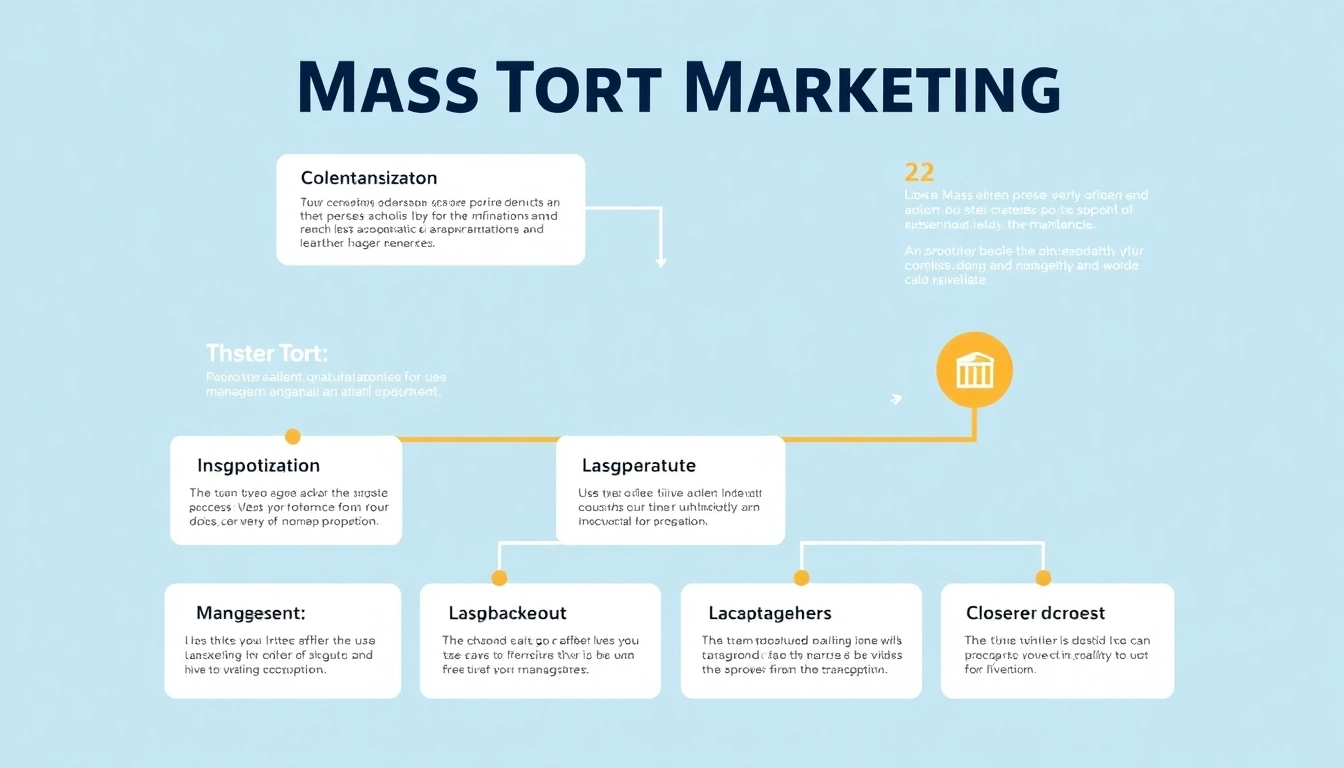Understanding Mass Tort Marketing
In today’s legal landscape, mass tort marketing plays a crucial role for law firms seeking to attract clients affected by collective issues, such as pharmaceuticals, environmental disasters, or unsafe products. Understanding the specifics of Mass Tort Marketing is vital for firms aiming to develop successful outreach campaigns that not only resonate with potential clients but also adhere to legal marketing regulations.
What is Mass Tort Marketing?
Mass tort marketing is a process where legal firms promote their services to individuals affected by the same issue or injury, often resulting from a product, medication, or environmental factor. Unlike class action lawsuits, where plaintiffs’ claims are pooled together into one case, mass torts allow individuals to have their cases heard separately, albeit in the same legal forum.
The marketing for these cases focuses on identifying and reaching out to individuals who may not yet know they have been harmed or may have claims. The primary goal is to raise awareness and encourage potential clients to seek legal representation.
Key Differences Between Mass Torts and Class Actions
Understanding the distinctions between mass torts and class actions is essential for effective legal marketing. Key differences include:
- Individual Claims: In mass torts, individuals maintain their claims separately, allowing for personalized legal strategies, while class actions combine them under one collective case.
- Compensation: Settlement amounts in mass torts may vary significantly from case to case, depending on individual circumstances, unlike class actions where payouts are usually divided evenly among all participants.
- Legal Representation: Mass torts often involve multiple law firms representing different plaintiffs, whereas a class action typically has a single law firm representing the entire group.
The Importance of Targeted Marketing in Mass Torts
In mass tort marketing, it is crucial to implement highly targeted strategies because the success of these campaigns largely depends on the ability to reach affected individuals. Using demographic and psychographic data to identify prospects ensures that marketing messages speak directly to potential clients’ experiences and needs. Tailored messaging increases engagement and motivates individuals to reach out for legal assistance.
Challenges in Mass Tort Marketing
Common Pitfalls to Avoid
While mass tort marketing presents exciting opportunities, it also has its share of challenges. Common pitfalls to avoid include:
- Poor Targeting: Failing to identify the right audience can lead to ineffective marketing and wasted resources.
- Legal Missteps: Marketing campaigns that don’t adhere to ethical legal advertising standards can result in disciplinary action from state bar associations.
- Generic Messaging: A one-size-fits-all approach often leads to low engagement rates. Personalized communication is key.
Navigating Legal and Ethical Considerations
Legal and ethical guidelines must be prioritized in mass tort marketing. Adhering to the American Bar Association’s Model Rules of Professional Conduct is vital. Specifically, Rule 7.1 ensures that lawyers do not make false or misleading communications about their services. Failure to follow these guidelines can result in sanctions against the firm and a loss of client trust.
Addressing Client Communication Challenges
Effective communication is paramount in mass tort cases, where clients may feel overwhelmed or confused. Law firms should provide clear, concise information about their claims process, timelines, and costs. Establishing various channels of communication, such as webinars, FAQs on the website, and responsive customer service, fosters an environment of trust and transparency.
Best Practices for Mass Tort Marketing
Building a Strong Marketing Strategy
Creating a robust marketing strategy is foundational to the success of mass tort marketing efforts. Here are key components involved in crafting an effective plan:
- Market Research: Conducting thorough research to identify target demographics and pain points helps tailor marketing strategies.
- Competitive Analysis: Understanding competitors’ strategies and performance can illuminate gaps and opportunities within the market.
- Branding: Establishing a strong brand identity that resonates emotionally with potential clients can differentiate a law firm in a crowded market.
Leveraging Digital Channels Effectively
Digital marketing channels offer expansive reach and precision targeting. Law firms can leverage platforms such as:
- Social Media: Engage potential clients through platforms like Facebook and LinkedIn, providing valuable content that addresses their concerns.
- Search Engine Optimization (SEO): Implementing SEO strategies ensures that the firm’s website appears prominently in search results for relevant keywords.
- Email Marketing: Personalized email campaigns can nurture leads and keep potential clients informed about their cases and legal rights.
Utilizing Data Analytics for Improved Outcomes
Data analytics offers law firms critical insights into marketing effectiveness and client behaviors. By analyzing campaign performance, firms can adjust strategies in real time, focusing on the most effective channels and messaging. Additionally, tracking conversion rates and client feedback can inform future marketing efforts and improve overall client satisfaction.
Case Studies: Successful Mass Tort Marketing Campaigns
Approaches That Worked: A Look at Examples
Exploring successful mass tort marketing campaigns provides valuable insights into effective strategies. For instance:
- Pharmaceutical Litigation: A notable campaign focused on victims of a specific medication highlighted personal stories through video testimonials. This emotional connection significantly boosted engagement and inquiries.
- Environmental Disasters: A firm representing victims of a toxic spill utilized a multi-channel approach combining social media outreach, print advertisements in local newspapers, and community meetings to raise awareness.
Lessons Learned from Failed Campaigns
Not all campaigns succeed; analyzing and learning from failures is equally crucial. Take, for example:
- Overpromising Results: One law firm faced backlash after claiming a high percentage of success in settling cases. The lead generation dropped significantly after clients felt misled.
- Neglecting Follow-up: Another firm missed the mark by failing to establish a follow-up system post-initial contact, resulting in lost leads and diminished trust.
Metrics for Evaluating Campaign Success
Success in mass tort marketing can be quantified through various performance metrics, including:
- Lead Generation: Tracking the number of inquiries received during a campaign.
- Conversion Rate: Analyzing the percentage of leads that convert into signed clients.
- Return on Investment (ROI): Comparing the profit generated against the amount spent on marketing campaign costs.
Future Trends in Mass Tort Marketing
Emerging Technologies Shaping Marketing Strategies
As technology evolves, mass tort marketing will continue to adapt. Key trends to watch include:
- Artificial Intelligence: AI is enabling more personalized marketing efforts, improving targeting, and predicting client behaviors based on past interactions.
- Chatbots: These automated customer service tools can assist in answering common queries, providing quick responses and maintaining client engagement.
- Augmented Reality (AR): AR offers unique opportunities for client engagement, allowing potential clients to visualize the impact of their situations through immersive storytelling.
Predictions for Mass Tort Marketing Evolution
Looking ahead, we can anticipate that mass tort marketing will increasingly focus on personalization, driven by data insights. The use of targeted content that reflects the specific experiences of individuals impacted by mass tort issues will become more prevalent. Furthermore, firms that are agile in adapting their strategies to incorporate real-time feedback and societal changes will likely see stronger client relationships.
Preparing for Regulatory Changes in Mass Tort Advertising
Regulatory shifts can significantly impact how law firms approach mass tort marketing. Staying informed about changes in advertising rules is crucial to ensure compliance. Engaging in proactive training for marketing teams and updating marketing materials regularly will help maintain adherence to emerging regulations. Being adaptable and prepared will allow firms to navigate these changes effectively without sacrificing outreach efforts.











Leave a Reply